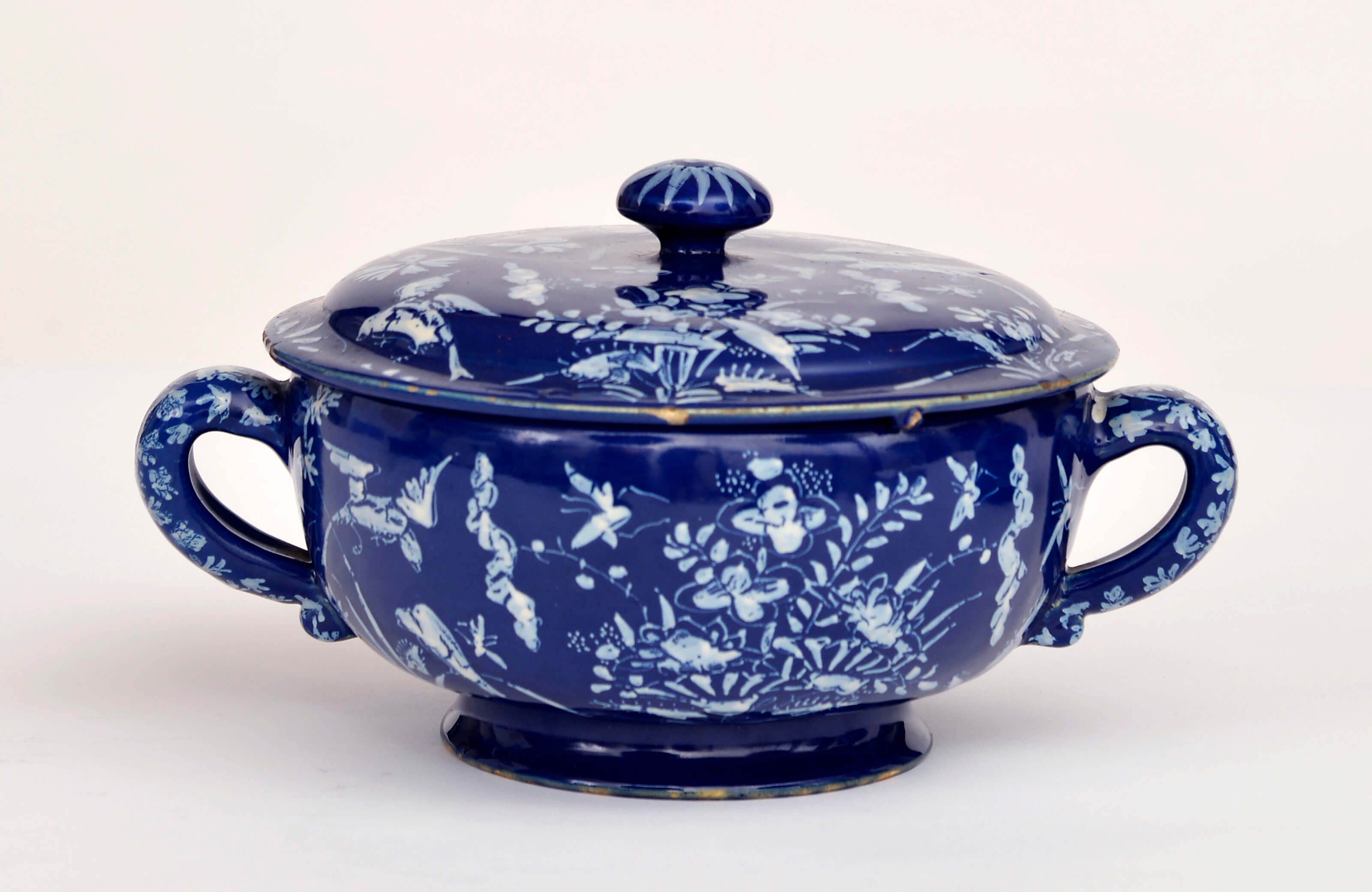
Persian Blue
Around 1700 the Dutch pottery painters in Delft were experimenting with beautiful intense blue grounds. Nowadays, we call this ‘Persian Blue’ originally from the ‘Bleu Persan’.
By the end of the seventeenth century, potters were so skilled in keeping the tin glaze stable during the fire, that they could experiment with decorations. At some factories, the highly shiny glaze was colored through and through blue, olive green or even black. On top of this glaze, a decoration was painted in a lighter color, such as yellow, white, red or green. The painters at De Metaale Pot (The Metal Pot) Factory were very skilled in the production of colored grounds and rare black glazes, and at Het Jonge Moriaanshooft (The Young Moor’s Head), Lieve van Dalen was famous for his objects with brown or olive green grounds. De Paauw (The Peacock) Factory is most renowned for its blue glazes. A beautiful example, already mentioned in an earlier newsletter, is a spice bowl with a blue glaze and white decorations.
This group of unusual Delftware, with blue grounds, in the truest sense of the word, was inspired by the French products with blue or yellow grounds from Nevers, France. During a short period between 1660-1680, faience makers in Nevers were producing wares with either an opaque yellow or blue glaze, covered with delicate lacelike decorations, what of course was the reason why this blue earthenware is also called ‘Nevers bleu’. Musée National de Céramique in Sèvres has wonderful examples of this ‘Nevers bleu’ in its collection.[1] The French potters in their turn learned how to make the colored grounds from their Italian colleagues that were at work in Nevers. Since the blue grounds in Italian earthenware are called ‘berettino’, this word sometimes also refers to these French blue wares.[2] Early in the sixteenth century, the local potters in Faenza, Italy, colored their tin glaze through and through, in lighter or darker shades of blue. Dishes covered in this ‘berettino‘ blue ground would be decorated in different colors as white, light blue and yellow. These wares already inspired the majolica factories in Haarlem around 1620-1640 to cover their majolica with a glaze varying from almost turquoise to a deep cobalt blue. And, indirectly, it was the spark for the development of ‘Persian blue’ around 1700.
It is thought that this unusual blue faience was produced originally imitating the blue-glazed Eastern wares. It was in the Iranian potters workshops, that the first opaque blue glazes were invented to give the objects the look of Chinese underglaze blue porcelain. As discussed in the article The History of Underglaze Blue in this same newsletter, the earthenwares created in Persia, with modern day Iran as its centre could be colored allover in blue, turquoise or green. They used opaque glazes in their decoration, but also produced earthenware with transparent glazes applied on top of underglaze decorations in black or manganese.
It was a difficult technique, since the decoration could ‘sink’ into the coloured ground during firing. In Delft, they were able to improve the technique, and stop the glaze from running. Still, it is easy to spot the cracking in the white decorations of our blue spiced wine bowl, showing how difficult it is to manage the firing and the needed temperatures.[3] Other beautiful examples, all marked for De Paauw (The Peacock) Factory are in Musées Royaux d’Art et d’ Histoire, illustrated in Helbig, Faïence Hollandaises, vol.1 Pièces marquées, p. 207. In the Aronson Catalogue of 2011, p. 24-25 two ‘Persian blue’ are illustrated, showing the delicate effect of the white decoration on the intense cobalt blue.
[1] A.Faÿ- Hallé, C. Lahaussois, Several objects are illustrated in La Faïence Européenne au XVIIe siècle, Le Triomphe de Delft, Paris, 2003, pp. 178,179, 180.
[2] M. van Aken-Fehmers, Geschiedenis van een Nationaal Product, Zwolle, 2001, p. 165.
[3] J.D. van Dam, Delffse Porceleyne, Dutch Delftware 1620-1850, Rijksmuseum Amsterdam, 2004, 118-119.



